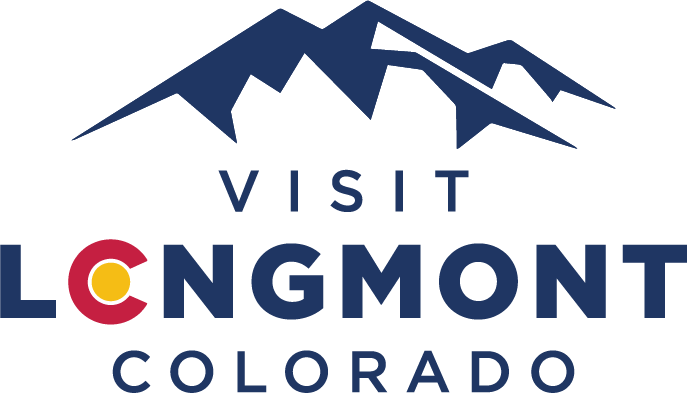
- HOME
- Things To Do
- Arts & Culture
- Art Galleries
- Art In Public Places
- Murals
- Performing Arts/Theatre
- Attractions
- Downtown Longmont
- Cheese Importers
- Cheese Making
- Hot Air Ballooning
- Mile-Hi Skydiving
- Day Trips from Longmont
- Dog Friendly
- Family Fun
- Farms & Farmer's Markets
- Longmont Farmers Market
- Farm Dinners
- Live Music
- Longmont Sunsets
- Museums & History
- Longmont Museum
- Longmont History
- Hygiene, CO
- Stephen H. Long
- J.C. Penney
- Tower of Compassion
- Teddy Roosevelt
- The Callahan House
- Ken Pratt
- Haunted History
- Sandstone Ranch
- Imperial Hotel
- Chief Niwot and the Left Hand Curse
- Dickens Opera House
- Ed Jones Building
- Parks & Outdoors
- Biking
- Birding
- Dickens Farm Nature Area & Tubing
- Fishing
- Golden Ponds
- Hiking
- Lakes & Rivers
- McIntosh Lake Nature Area
- Union Reservoir
- St. Vrain State Park
- Rocky Mountain National Park
- Shopping & Entertainment
- Spend the Day in Longmont
- Sports
- Golf
- Disc Golf
- Swimming
- Water Sports
- Winter
- Top Things To Do
- Wellness
- HOME
- Restaurants
- Asian
- Bars & Pubs
- Brunch
- Coffee Shops, Bakeries, and Ice Cream
- National Coffee Day
- Indian & Nepali
- Mexican
- Featured On TV
- Farmers Markets
- HOME
- Plan
- About Longmont
- Facts & Figures
- Multicultural Heritage
- History
- Old Town Longmont
- Prospect New Town
- eNewsletter
- Itineraries
- Winter
- Spring
- Summer
- Fall
- Carbonation + Elevation
- Girl's Weekend
- Perfect Longmont Itinerary
- Moving To Longmont
- Tips For Visitors
- Visitor Center
- Visitors Guide
- Digital Visitors Guide
- Transportation
Boulder County Fair
The Boulder County Fair is an annual fair hosted at the Boulder County Fairgrounds located at 9595 Nelson Road in Longmont every summer.
Cover Photo: Toby Shepard.
The Boulder County Fair returns for 2023!
Thur, Aug 10 - Sun, Aug 13
10am - 10pm daily
Carnival opens at 2:00pm
The Boulder County Fair is the oldest fair in Colorado celebrating its 154th year. The Fair is a non-profit that rents the grounds and facilities from Boulder County who in turn is the main sponsor supporting the 4-H and open events during the Fair. The Fair is a "Free" fair meaning no charge for parking or gate admission so please come as often as you would like.
The fair celebrates our rich agricultural culture, traditions and community. At the Boulder County Fair, there is something for everyone. Learn more at www.bouldercountyfair.org
History
The Boulder County Fair began with a group of prominent, local farmers and ranchers. These early pioneers envisioned a community event that would celebrate the rich diversity of the area and display area resident’s projects and everyday activities through exhibits. The Fair would be a boom for the country’s economy and a showcase for the Boulder County lifestyle.
40 acres of land was purchased between (current day) 28th and 30th Streets, south of Valmont Road in Boulder for $600, and the fair was planned for mid-October. A pavilion, refreshment stands and stalls were erected, and the first fair was held in the Colorado Territory (Colorado earned statehood in 1876) on October 12, 1869. This first fair ran for four days with displays that featured flowers, vegetables, cereals and handmade crafts. There were also five classes of exhibits: Class A - Farming: Livestock and Farm Machinery; Class B - articles manufactured in Colorado; Class C - Mineralogy: displays of gold and silver bullion from Boulder County mines and additional minerals and geological specimens found in the state; Class D- Agriculture and Vegetables; Class E- Household and Pantry Goods. Each day also featured horse races, and the fair concluded with a mule race. The cost of this first fair was $5,000 (approximately $165,000 in today’s dollars).
In 1870, a round house was built for the mineral and agricultural displays as well as additional stalls, saloons and corrals. In 1875, a grandstand, with a seating capacity of 1,000, was added to the site and horseracing increasingly became the main attraction. By 1877, farm machinery became the big attraction, especially steam-powered machines.
The City of Longmont became the fair’s host in 1885. The event in Boulder continued to deviate from the original agricultural focus, so the fair was moved and renamed “Pumpkin Pie Days” while the horse racing and gambling attractions remained in Boulder, along with a smaller exhibition. On October 5, 1899, the Boulder County Fair was officially moved to Roosevelt Park in Longmont. That year the fair was only one day, but it featured events like traditional horse racing, as well as, livestock and home economics exhibits. The women of Boulder County honored Pumpkin Pie Days by making enough homemade pies to feed the entire fair crowd, free of charge.
Today, the fair features a wide range of activities like a carnival, concerts, vendors, crafts, livestock shows, 4-H competitions, rodeos and much more. There are many free educational, agricultural, and interactive activities and kids will love the petting zoo. Grab some cotton candy and hop on a carnival ride – the fair offers unlimited ride wristbands and a discounted Kid’s Day for rides every year. Check out the competition with the 4-H contestants. You’ll see everything from livestock to arts & crafts on display, and you can appreciate the hard work of many area youngsters. Entrance to the fair is free for visitors with no charge for parking. Some special events do charge admission such as rodeos, motorized sporting demos and signature grandstand events.

